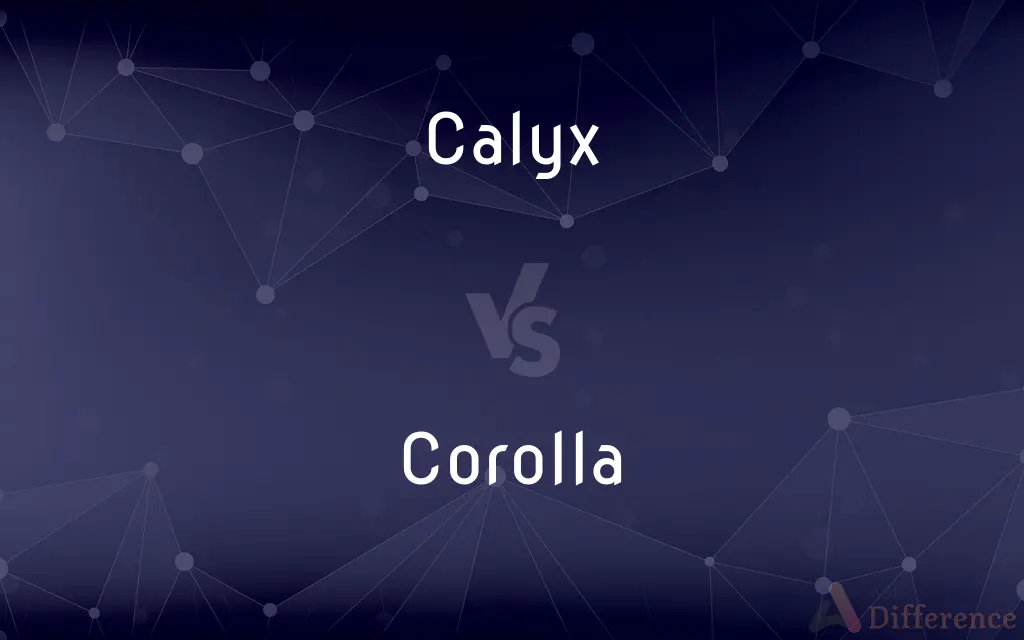Calyx vs. Corolla — What's the Difference?
Edited by Tayyaba Rehman — By Fiza Rafique — Updated on October 5, 2023
Calyx is the outermost whorl of a flower, composed of sepals; Corolla is the next inner whorl, composed of petals.

Difference Between Calyx and Corolla
Table of Contents
ADVERTISEMENT
Key Differences
Calyx is the term used to refer to the outermost whorl of a flower, which primarily serves to protect the inner parts of the flower bud. This outer whorl is made up of individual units known as sepals. Corolla, on the other hand, is the term for the next inner whorl found after the calyx. It comprises the petals of the flower, which are often colorful and help attract pollinators.
In many plants, the Calyx appears green and is often mistaken as a part of the plant's foliage. Its main function is protection, particularly when the flower is still in bud form. The Corolla, with its vibrant and varied colors, is more noticeable and is frequently the most distinctive part of a flower. Its primary role is to attract insects and other pollinators, aiding in the reproduction process.
The components of the Calyx, the sepals, can sometimes be fused together, forming a structure called a tube or calyculus. While sepals are typically leaf-like and green, there are some plants where they can be colorful and petal-like. In contrast, the Corolla consists of petals, which can be free or united. When the petals are fused, they form a tubular, bell, or funnel-shaped structure.
When it comes to their developmental pattern, the Calyx is the first to form as the flower develops. It provides the necessary protection for the young and developing flower parts inside it. The Corolla develops after the calyx and is crucial for the mature function of the flower, especially in the processes of pollination and reproduction.
Both Calyx and Corolla are essential parts of a complete flower. They play pivotal roles in the flower's life cycle. While the calyx offers protection, the corolla ensures the flower’s reproduction by attracting the necessary agents for pollination.
ADVERTISEMENT
Comparison Chart
Part of Flower
Outermost whorl
Next inner whorl after calyx
Composed of
Sepals
Petals
Function
Protection
Attraction of pollinators
Appearance
Typically green
Typically colorful
Development
Forms first in a flower
Develops after the calyx
Compare with Definitions
Calyx
The outermost whorl of a flower, usually green.
The calyx of the rosebud protected its delicate inner petals.
Corolla
The collective term for all the petals of a flower.
The corolla of the sunflower was bright and cheerful.
Calyx
The part of the flower that often remains after the petals fall off.
Even after the bloom withered, the calyx remained attached to the stem.
Corolla
The whorl of a flower that is often brightly colored to attract pollinators.
The vibrant corolla of the hibiscus attracted bees and butterflies.
Calyx
A structure that can be fused or separate, forming the base of the flower.
The fused calyx of the morning glory gave it a unique appearance.
Corolla
Can be tubular, bell, or funnel-shaped when petals are fused.
The corolla of the trumpet vine was tubular, drawing in hummingbirds.
Calyx
A protective covering for the flower bud.
The calyx encased the young flower, ensuring its safety from external elements.
Corolla
Often the most visually striking part of a flower.
The corolla's vivid hues made the garden come alive in spring.
Calyx
The collective term for all the sepals of a flower.
The calyx of the tulip was as striking as its vibrant petals.
Corolla
The part of the flower directly inside the calyx.
Hidden inside the protective calyx, the corolla of the bud was waiting to bloom.
Calyx
(Botany) The outermost part of a flower, consisting of the sepals.
Corolla
The petals of a flower considered as a group or unit and usually of a color other than green; the inner whorl of the perianth.
Calyx
(Anatomy) A cuplike structure, such as the collecting structures into which the pelvis of the kidney is divided.
Corolla
(botany) An outermost-but-one whorl of a flower, composed of petals, when it is not the same in appearance as the outermost whorl (the calyx); it usually comprises the petal, which may be fused.
Calyx
(Ecclesiastical) A calix.
Corolla
The inner envelope of a flower; the part which surrounds the organs of fructification, consisting of one or more leaves, called petals. It is usually distinguished from the calyx by the fineness of its texture and the gayness of its colors. See the Note under Blossom.
Calyx
(botany) The outermost whorl of flower parts, comprising the sepals, which covers and protects the petals as they develop.
Corolla
(botany) the whorl of petals of a flower that collectively form an inner floral envelope or layer of the perianth;
We cultivate the flower for its corolla
Calyx
Any of various cup-like structures.
Calyx
A chamber in the mammalian kidney through which urine passes.
Calyx
The crown containing the viscera of crinoids and similar echinoderms, entoprocts, and the polyps of some cnidarians.
Calyx
A funnel-shaped expansion of the vas deferens or oviduct of insects.
Calyx
A flattened cap of neuropil in the brain of insects.
Calyx
The covering of a flower. See Flower.
Calyx
A cuplike division of the pelvis of the kidney, which surrounds one or more of the renal papillæ.
Calyx
(botany) the whorl of sepals of a flower collectively forming the outer floral envelope or layer of the perianth enclosing and supporting the developing bud; usually green
Common Curiosities
Can "calyx" refer to anything other than a part of a flower?
Yes, "calyx" can also refer to similar-shaped anatomical structures in animals or humans, such as the renal calyx in kidneys.
Is the "corolla" always colorful?
While corollas are often colorful, they can sometimes be green or dull, particularly in species where wind or water, rather than animals, facilitates pollination.
How does a "corolla" relate to a flower?
The corolla is the part of a flower that is usually colorful and contains the petals, which are often responsible for attracting pollinators.
What is a "calyx" in botanical terms?
The calyx is the outermost part of a flower, typically green, composed of sepals that protect the flower bud before it blooms.
Is the calyx always present in all flowers?
Most flowers have a calyx, but its presence, size, and form can vary significantly among different plant species.
What happens to the "calyx" after a flower blooms?
Post-blooming, the calyx may either persist and sometimes become altered to assist in fruit dispersal, or it may wither and fall off.
What is meant by "calyx tube"?
A calyx tube refers to the portion of the calyx where all the sepals are fused together, forming a tube-like structure.
What is a "double flower"?
A double flower is a mutation or cultivar where the number of petals (corolla) is significantly increased, often at the expense of reproductive organs.
What is the function of the "corolla" in a flower?
The corolla primarily functions to attract pollinators through its color, shape, and sometimes scent, aiding in the process of pollination.
What is a "petal" in relation to the "corolla"?
A petal is an individual segment or piece of the corolla. Collectively, all the petals of a flower form the corolla.
Can the "corolla" and "calyx" be fused together?
Yes, in some flowers, the corolla and calyx are fused, forming a structure known as a perianth, especially when it's hard to distinguish between sepals and petals.
What is the "sepals" relationship with the "calyx"?
Sepals are individual units or segments of the calyx, and collectively, they form the entire calyx structure in a flower.
Can the "calyx" be colorful?
While typically green, in some plant species, the calyx is colorful and petal-like, sometimes mistaken for the corolla.
Is the corolla essential for all flowering plants?
Not always. Some flowers, like grasses, lack a distinctive corolla, using other means, like wind, to achieve pollination without attracting pollinators.
Does the "calyx" play a role in pollination?
Although not its primary function, the calyx can play a role in pollination by protecting the reproductive structures and sometimes aiding in attracting pollinators when it's colorful or modified.
Share Your Discovery

Previous Comparison
Agreement vs. Covenant
Next Comparison
Store vs. RestoreAuthor Spotlight
Written by
Fiza RafiqueFiza Rafique is a skilled content writer at AskDifference.com, where she meticulously refines and enhances written pieces. Drawing from her vast editorial expertise, Fiza ensures clarity, accuracy, and precision in every article. Passionate about language, she continually seeks to elevate the quality of content for readers worldwide.
Edited by
Tayyaba RehmanTayyaba Rehman is a distinguished writer, currently serving as a primary contributor to askdifference.com. As a researcher in semantics and etymology, Tayyaba's passion for the complexity of languages and their distinctions has found a perfect home on the platform. Tayyaba delves into the intricacies of language, distinguishing between commonly confused words and phrases, thereby providing clarity for readers worldwide.
















































